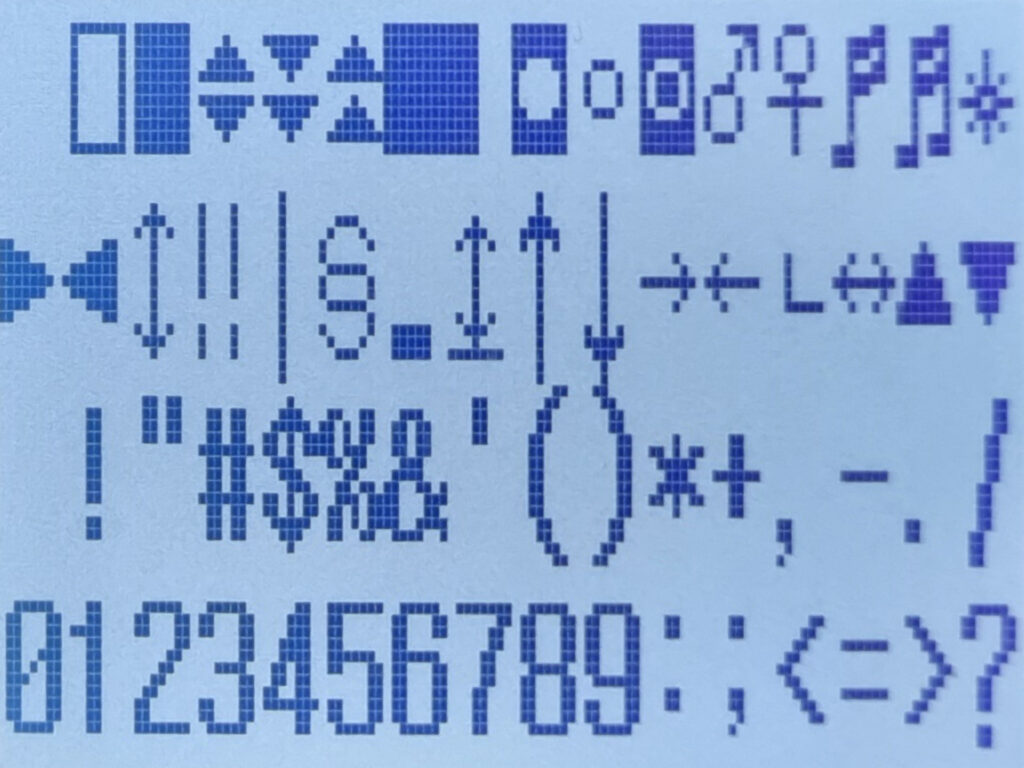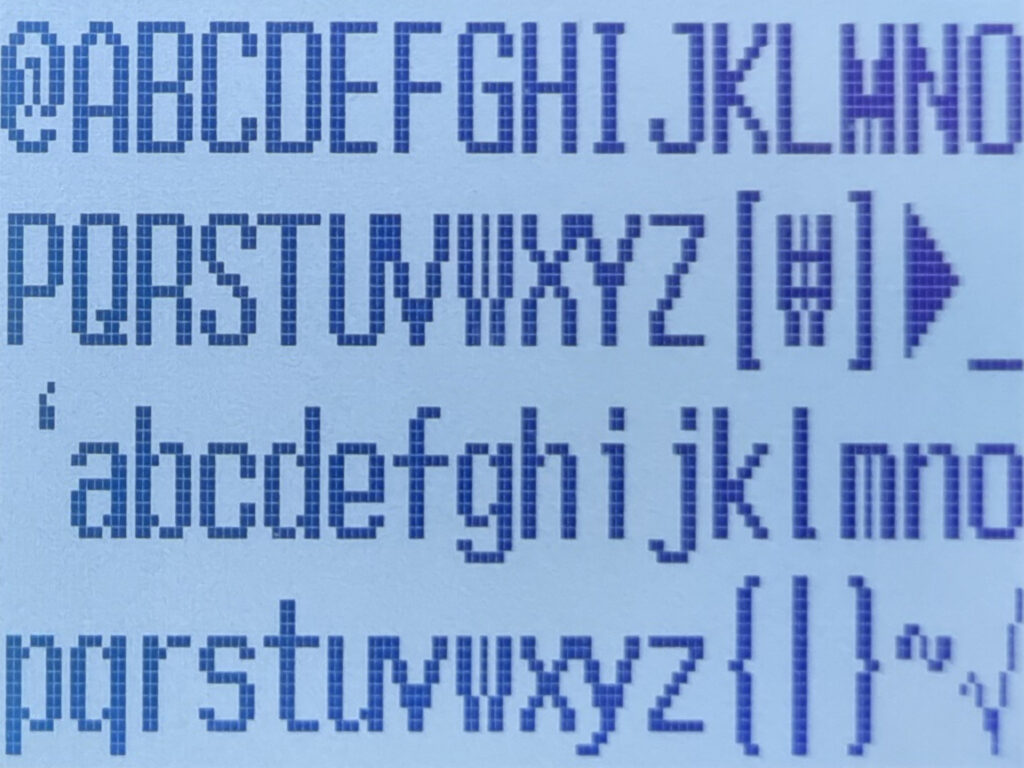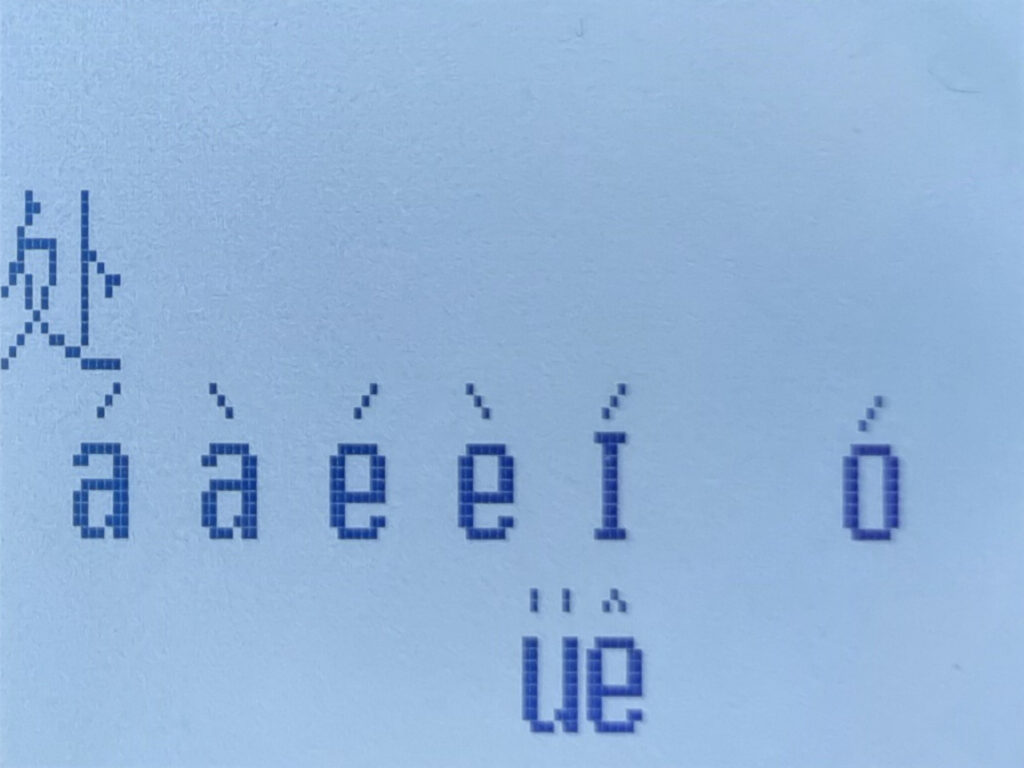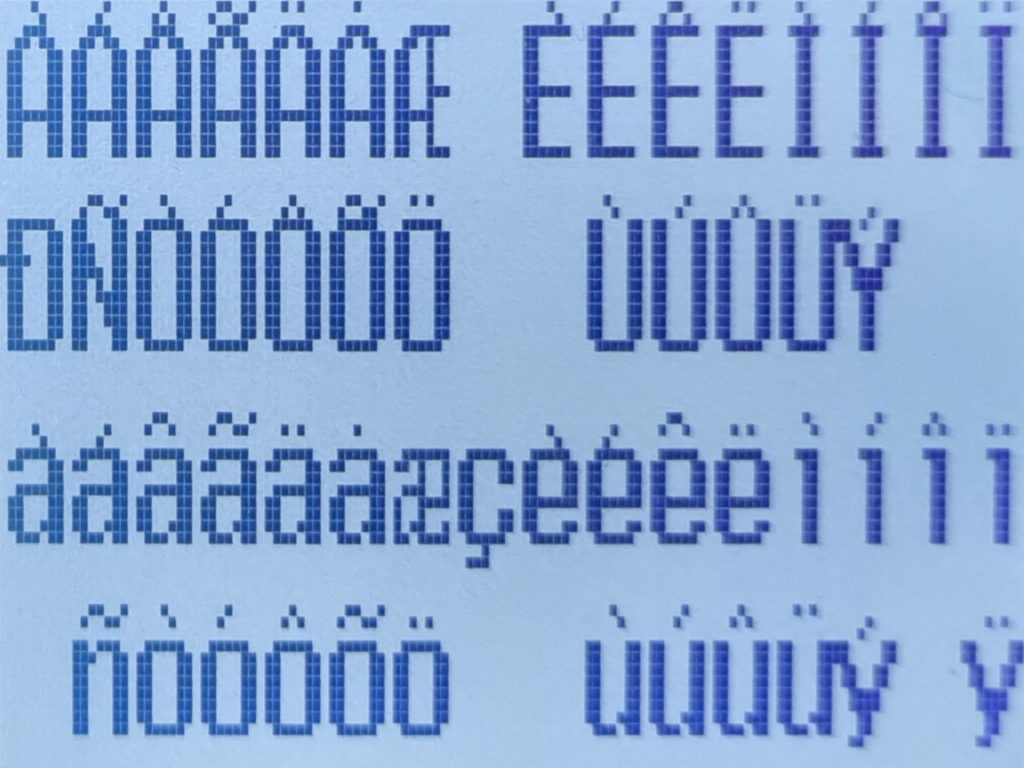If you’re the curious type (quite possible) and you’ve been playing with an Allen Bradley Micro810 (less likely) you might have wondered what special characters you can put on the screen.
And you’d stay curious if you tried to find the answer in the Allen Bradley Documentation, because it’s shit: It doesn’t even tell you how many characters there are on a each line. Incidentally, the answer is 16.
Entering the characters into strings is pretty easy – just type $ followed by the 2 digit Hex code. e.g. ‘Hello$21’ would appear as Hello!.
The first 32 are dramatically different to the ASCII standard, and well worth knowing about, but there are a few others different 5C,5E & 7F. Codes 80 to FF are less useful, but there are a few accented characters in there that might be of use, depending on which language you use.
I wrote a simple program to show every code across 4 pages – use the left and right buttons to switch between them. This was prepared with Connected Components Workbench 22.0.0 for a Micro810 with v7 firmware.
Characters 00 – 3F (0-63)
Loads of goodies in here, look!
| HEX | DEC | Symbol | ASCII Description | Micro810 Display |
|---|---|---|---|---|
| 00 | 0 | NUL | Null char | Space |
| 01 | 1 | SOH | Start of Heading | Empty Box |
| 02 | 2 | STX | Start of Text | Filled Box |
| 03 | 3 | ETX | End of Text | Up/down arrows |
| 04 | 4 | EOT | End of Transmission | Double down arrow |
| 05 | 5 | ENQ | Enquiry | Double Up arrow |
| 06 | 6 | ACK | Acknowledgment | Filled Box |
| 07 | 7 | BEL | Bell | Vertical Bar |
| 08 | 8 | BS | Back Space | Filled box with hole |
| 09 | 9 | HT | Horizontal Tab | Circle |
| 0A | 10 | LF | Line Feed | Filled box with circle |
| 0B | 11 | VT | Vertical Tab | Male Symbol |
| 0C | 12 | FF | Form Feed | Female Symbol |
| 0D | 13 | CR | Carriage Return | 1 musical note |
| 0E | 14 | SO | Shift Out / X-On | 2 musical notes |
| 0F | 15 | SI | Shift In / X-Off | Star |
| 10 | 16 | DLE | Data Line Escape | Right Arrow |
| 11 | 17 | DC1 | Device Control 1 (oft. XON) | Left arrow |
| 12 | 18 | DC2 | Device Control 2 | Up/down arrow thin |
| 13 | 19 | DC3 | Device Control 3 (oft. XOFF) | Something, not sure what |
| 14 | 20 | DC4 | Device Control 4 | Vertical line |
| 15 | 21 | NAK | Negative Acknowledgement | Section sign |
| 16 | 22 | SYN | Synchronous Idle | Small filled box |
| 17 | 23 | ETB | End of Transmit Block | Up/down arrow 3 |
| 18 | 24 | CAN | Cancel | Up arrow thin |
| 19 | 25 | EM | End of Medium | Down arrow thin |
| 1A | 26 | SUB | Substitute | Right arrow thin |
| 1B | 27 | ESC | Escape | Left arrow thin |
| 1C | 28 | FS | File Separator | Small “L” |
| 1D | 29 | GS | Group Separator | Lef/Right arrow thin |
| 1E | 30 | RS | Record Separator | Up Arrow |
| 1F | 31 | US | Unit Separator | Down arrow |
| 20 | 33 | Space | ||
| 21 | 33 | ! | Exclamation mark | |
| 22 | 34 | “ | Double quotes (or speech marks) | |
| 23 | 35 | # | Number | |
| 24 | 36 | $ | Dollar | |
| 25 | 37 | % | Percentage | |
| 26 | 38 | & | Ampersand | |
| 27 | 39 | ‘ | Single quote | |
| 28 | 40 | ( | Open parenthesis (or open bracket) | |
| 29 | 41 | ) | Close parenthesis (or close bracket) | |
| 2A | 42 | * | Asterisk | |
| 2B | 43 | + | Plus | |
| 2C | 44 | , | Comma | |
| 2D | 45 | – | Hyphen | |
| 2E | 46 | . | Period, dot or full stop | |
| 2F | 47 | / | Slash or divide | |
| 30 | 48 | 0 | Zero | |
| 31 | 49 | 1 | One | |
| 32 | 50 | 2 | Two | |
| 33 | 51 | 3 | Three | |
| 34 | 52 | 4 | Four | |
| 35 | 53 | 5 | Five | |
| 36 | 54 | 6 | Six | |
| 37 | 55 | 7 | Seven | |
| 38 | 56 | 8 | Eight | |
| 39 | 57 | 9 | Nine | |
| 3A | 58 | : | Colon | |
| 3B | 59 | ; | Semicolon | |
| 3C | 60 | < | Less than (or open angled bracket) | |
| 3D | 61 | = | Equals | |
| 3E | 62 | > | Greater than (or close angled bracket) | |
| 3F | 63 | ? | Question mark |
Characters 40-7F
Most of these are pretty similar to standard ASCII, but with a few exceptions
| HEX | DEC | Symbol | ASCII Description | Micro810 Display |
|---|---|---|---|---|
| 40 | 64 | @ | At symbol | |
| 41 | 65 | A | Uppercase A | |
| 42 | 66 | B | Uppercase B | |
| 43 | 67 | C | Uppercase C | |
| 44 | 68 | D | Uppercase D | |
| 45 | 69 | E | Uppercase E | |
| 46 | 70 | F | Uppercase F | |
| 47 | 71 | G | Uppercase G | |
| 48 | 72 | H | Uppercase H | |
| 49 | 73 | I | Uppercase I | |
| 4A | 74 | J | Uppercase J | |
| 4B | 75 | K | Uppercase K | |
| 4C | 76 | L | Uppercase L | |
| 4D | 77 | M | Uppercase M | |
| 4E | 78 | N | Uppercase N | |
| 4F | 79 | O | Uppercase O | |
| 50 | 80 | P | Uppercase P | |
| 51 | 81 | Q | Uppercase Q | |
| 52 | 82 | R | Uppercase R | |
| 53 | 83 | S | Uppercase S | |
| 54 | 84 | T | Uppercase T | |
| 55 | 85 | U | Uppercase U | |
| 56 | 86 | V | Uppercase V | |
| 57 | 87 | W | Uppercase W | |
| 58 | 88 | X | Uppercase X | |
| 59 | 89 | Y | Uppercase Y | |
| 5A | 90 | Z | Uppercase Z | |
| 5B | 91 | [ | Opening bracket | |
| 5C | 92 | \ | Backslash | Weird Portcullis thing |
| 5D | 93 | ] | Closing bracket | |
| 5E | 94 | ^ | Caret – circumflex | Right arrow tall (Cursor) |
| 5F | 95 | _ | Underscore | |
| 60 | 96 | ` | Grave accent | |
| 61 | 97 | a | Lowercase a | |
| 62 | 98 | b | Lowercase b | |
| 63 | 99 | c | Lowercase c | |
| 64 | 100 | d | Lowercase d | |
| 65 | 101 | e | Lowercase e | |
| 66 | 102 | f | Lowercase f | |
| 67 | 103 | g | Lowercase g | |
| 68 | 104 | h | Lowercase h | |
| 69 | 105 | i | Lowercase i | |
| 6A | 106 | j | Lowercase j | |
| 6B | 107 | k | Lowercase k | |
| 6C | 108 | l | Lowercase l | |
| 6D | 109 | m | Lowercase m | |
| 6E | 110 | n | Lowercase n | |
| 6F | 111 | o | Lowercase o | |
| 70 | 112 | p | Lowercase p | |
| 71 | 113 | q | Lowercase q | |
| 72 | 114 | r | Lowercase r | |
| 73 | 115 | s | Lowercase s | |
| 74 | 116 | t | Lowercase t | |
| 75 | 117 | u | Lowercase u | |
| 76 | 118 | v | Lowercase v | |
| 77 | 119 | w | Lowercase w | |
| 78 | 120 | x | Lowercase x | |
| 79 | 121 | y | Lowercase y | |
| 7A | 122 | z | Lowercase z | |
| 7B | 123 | { | Opening brace | |
| 7C | 124 | | | Vertical bar | |
| 7D | 125 | } | Closing brace | |
| 7E | 126 | ~ | Equivalency sign – tilde | |
| 7F | 127 | Delete | Square Root sign |
Characters 80-BF
A couple of Asian characters, and some common accented letters
| HEX | DEC | Symbol | Micro810 Display |
|---|---|---|---|
| 90 | 144 | Asian Symbol | |
| 91 | 145 | Asian Symbol | |
| A1 | 161 | á | Lowercase a with acute |
| A3 | 163 | à | Lowercase a with grave |
| A5 | 165 | é | Lowercase e with acute |
| A7 | 167 | è | Lowercase e with grave |
| A9 | 169 | Í | Uppercase I with acute |
| AD | 173 | ó | Lowercase o with acute |
| B8 | 184 | ü | Lowercase u with diaeresis |
| B9 | 185 | ê | Lowercase e with circumflex |
Characters C0-FF
A bunch of accented characters – these seem to be aligned to Unicode code points
| HEX | DEC | Symbol | Micro810 Display | Unicode |
|---|---|---|---|---|
| C0 | 192 | À | Uppercase A with grave | match |
| C1 | 193 | Á | Uppercase A with acute | match |
| C2 | 194 | Â | Uppercase A with circumflex | match |
| C3 | 195 | Ã | Uppercase A with tilde | match |
| C4 | 196 | Ä | Uppercase A with diaeresis | match |
| C5 | 197 | Ȧ | Uppercase A with overdot | Å: Uppercase A with overring (Ȧ: Uppercase A with overdot is at U+0226) |
| C6 | 198 | Æ | Uppercase AE | match |
| C7 | 199 | |||
| C8 | 200 | È | Uppercase E with grave | match |
| C9 | 201 | É | Uppercase E with acute | match |
| CA | 202 | Ê | Uppercase E with circumflex | match |
| CB | 203 | Ë | Uppercase E with diaeresis | match |
| CC | 204 | Ì | Uppercase I with grave | match |
| CD | 205 | Í | Uppercase I with acute | match |
| CE | 206 | Î | Uppercase I with circumflex | match |
| CF | 207 | Ï | Uppercase I with diaeresis | match |
| D0 | 208 | Ð | Uppercase Eth | match |
| D1 | 209 | Ñ | Uppercase N with tilde | match |
| D2 | 210 | Ò | Uppercase O with grave | match |
| D3 | 211 | Ó | Uppercase O with acute | match |
| D4 | 212 | Ô | Uppercase O with circumflex | match |
| D5 | 213 | Õ | Uppercase O with tilde | match |
| D6 | 214 | Ö | Uppercase O with diaeresis | match |
| D7 | 215 | |||
| D8 | 216 | |||
| D9 | 217 | Ù | Uppercase U with grave | match |
| DA | 218 | Ú | Uppercase U with acute | match |
| DB | 219 | Û | Uppercase U with circumflex | match |
| DC | 220 | Ü | Uppercase U with diaeresis | match |
| DD | 221 | Ý | Uppercase Y with acute | match |
| DE | 222 | |||
| DF | 223 | |||
| E0 | 224 | à | Lowercase a with grave | match |
| E1 | 225 | á | Lowercase a with acute | match |
| E2 | 226 | â | Lowercase a with circumflex | match |
| E3 | 227 | ã | Lowercase a with tilde | match |
| E4 | 228 | ä | Lowercase a with diaeresis | match |
| E5 | 229 | ȧ | Lowercase a with overdot | å: Lowercase a with overring (ȧ: Lowercase a with overdot is at U+0227) |
| E6 | 230 | æ | Lowercase ae | match |
| E7 | 231 | ç | ||
| E8 | 232 | è | Lowercase e with grave | match |
| E9 | 233 | é | Lowercase e with acute | match |
| EA | 234 | ê | Lowercase e with circumflex | match |
| EB | 235 | ë | Lowercase e with diaeresis | match |
| EC | 236 | ì | Lowercase i with grave | match |
| ED | 237 | í | Lowercase i with acute | match |
| EE | 238 | î | Lowercase i with circumflex | match |
| EF | 239 | ï | Lowercase i with diaeresis | match |
| F0 | 240 | |||
| F1 | 241 | ñ | Lowercase n with tilde | match |
| F2 | 242 | ò | Lowercase o with grave | match |
| F3 | 243 | ó | Lowercase o with acute | match |
| F4 | 244 | ô | Lowercase o with circumflex | match |
| F5 | 245 | õ | Lowercase o with tilde | match |
| F6 | 246 | ö | Lowercase o with diaeresis | match |
| F7 | 247 | |||
| F8 | 248 | |||
| F9 | 249 | ù | Lowercase u with grave | match |
| FA | 250 | ú | Lowercase u with acute | match |
| FB | 251 | û | Lowercase u with circumflex | match |
| FC | 252 | ü | Lowercase u with diaeresis | match |
| FD | 253 | ý | Lowercase y with acute | match |
| FE | 254 | |||
| FF | 255 | ÿ | Lowercase y with diaeresis | match |






